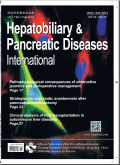- 钛学术文献服务平台 \
- 学术期刊 \
- 医药卫生期刊 \
- 内科学期刊 \
- 国际肝胆胰疾病杂志(英文版)期刊 \
Gallbladder perforation:A single-center experience in north India and a step-up approach for management
Gallbladder perforation:A single-center experience in north India and a step-up approach for management
基本信息来源于合作网站,原文需代理用户跳转至来源网站获取
摘要:
Background:Spontaneous gallbladder perforation(GBP)is an uncommon diagnosis.This study presented the experience of managing spontaneous GBP over nine years at a large,tertiary care university hospital in north India and investigated the outcomes and treatment strategies.Methods:A retrospective review of prospectively maintained digital database of consecutive patients was performed.All patients received medical and/or surgical treatment for spontaneous GBP in our depart-ment between January 2010 and June 2018.Results:We identified 151 patients(81 females and 70 males)with mean age of 53 years.Most common presenting features were pain(96.7%),fever(54.3%)and jaundice(31.1%).Most common cause was gall-bladder stones(84.8%)followed by common bile duct stones(30.5%),xanthogranulomatous cholecystitis(17.9%)and malignancy(11.9%).As per Niemeier classification,8.6%had type 1 GBP(free perforation in peritoneal cavity),76.2%had type 2 GBP(localized perforation)and 13.2%had type 3 GBP(cholecysto-enteric fistula).About 60%of the perforations were diagnosed preoperatively.Type 1 was more com-mon in patients with diabetes and also had the worst prognosis.Surgery was performed in 109 patients(72.2%).Seven patients(4.6%)had a postoperative morbidity of Clavien-Dindo Ⅲ or higher.There were three mortalities in patients who underwent surgery.Conclusions:High index of suspicion is required for preoperative diagnosis of GBP,especially in types 2 and 3.Laparoscopic cholecystectomy can be difficult in these patients and patients may require open or partial cholecystectomy.Early diagnosis and step-up approach for the treatment of GBP is critical.

推荐文章
RS码改进的step-by-step译码算法
RS码
step-by-step
译码算法
伴随式矩阵
Center服务的基准测试
呼叫中心
基准测试
测试范围
步骤
树状网络上k-tree center问题
树中心问题
树收缩
控制
Hydrogeochemical evaluation and statistical analysis of groundwater of Sylhet, north-eastern Banglad
Arsenic
Groundwater
Hydrogeochemistry
Multivariate statistics
Spatial distribution
内容分析
关键词云
关键词热度
相关文献总数
(/次)
(/年)
文献信息
| 篇名 | Gallbladder perforation:A single-center experience in north India and a step-up approach for management | ||
| 来源期刊 | 国际肝胆胰疾病杂志(英文版) | 学科 | |
| 关键词 | |||
| 年,卷(期) | 2022,(2) | 所属期刊栏目 | Biliary |
| 研究方向 | 页码范围 | 168-174 | |
| 页数 | 7页 | 分类号 | |
| 字数 | 语种 | 英文 | |
| DOI | |||
五维指标
引文网络
引文网络
二级参考文献 (0)
共引文献 (0)
参考文献 (0)
节点文献
引证文献 (0)
同被引文献 (0)
二级引证文献 (0)
2022(0)
- 参考文献(0)
- 二级参考文献(0)
- 引证文献(0)
- 二级引证文献(0)
引文网络交叉学科
相关学者/机构
期刊影响力
国际肝胆胰疾病杂志(英文版)
主办单位:
浙江大学医学院第一附属医院
出版周期:
双月刊
ISSN:
1499-3872
CN:
33-1391/R
开本:
大16开
出版地:
浙江省杭州市庆春路79号
邮发代号:
创刊时间:
2002
语种:
eng
出版文献量(篇)
1879
总下载数(次)
0
总被引数(次)
8662
期刊文献
相关文献
推荐文献
- 期刊分类
- 期刊(年)
- 期刊(期)
- 期刊推荐
国际肝胆胰疾病杂志(英文版)2022
国际肝胆胰疾病杂志(英文版)2021
国际肝胆胰疾病杂志(英文版)2020
国际肝胆胰疾病杂志(英文版)2019
国际肝胆胰疾病杂志(英文版)2018
国际肝胆胰疾病杂志(英文版)2017
国际肝胆胰疾病杂志(英文版)2016
国际肝胆胰疾病杂志(英文版)2015
国际肝胆胰疾病杂志(英文版)2014
国际肝胆胰疾病杂志(英文版)2013
国际肝胆胰疾病杂志(英文版)2012
国际肝胆胰疾病杂志(英文版)2011
国际肝胆胰疾病杂志(英文版)2010
国际肝胆胰疾病杂志(英文版)2009
国际肝胆胰疾病杂志(英文版)2008
国际肝胆胰疾病杂志(英文版)2007
国际肝胆胰疾病杂志(英文版)2006

 免费查重
免费查重










